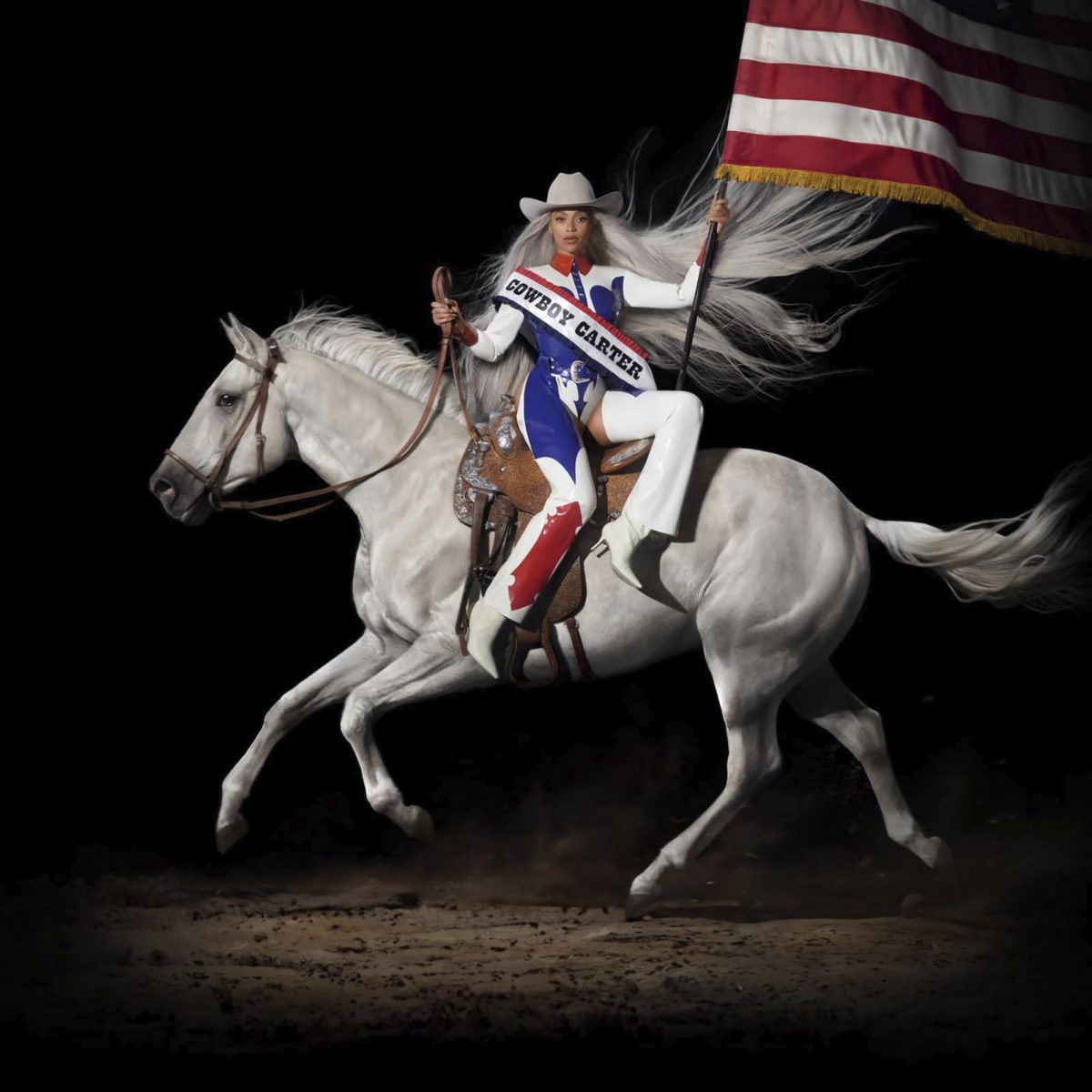At the end of Verizon’s ad during the 2024 Super Bowl, Beyoncé announced the release of her new album “Cowboy Carter.” She released “16 CARRIAGES” and “TEXAS HOLD ‘EM” as twin singles, both causing chaos. Cowboy hats? A banjo? “Oh no! Is Beyoncé releasing country music? Heck no!” some wailed, worried for the purity of their favorite genre.
“Cowboy Carter” is Beyoncé Knowles-Carter’s eighth studio album and the sequel to “Renaissance.” It consists of 27 tracks — 11 more than “Renaissance” — to a total of an hour and 18 minutes, featuring Miley Cyrus, Post Malone, Dolly Parton, Willie Nelson, Rhiannon Giddens, Tanner Adell and Willie Jones.
This is not the first time the Texan trailblazer has dipped her toes in fueling the anger of country music fans. Her revenge-fueled album “Lemonade” featured “Daddy Lessons,” a thwacking, knee-bopping, fiddling ode to her rough father. She performed it live at the Country Music Association Awards with The Chicks, formerly called the Dixie Chicks, only to receive tweets afterwards commenting on her performance.
What was the issue? We still don’t know. Some say that it was because the show should never “promote radical BLM militants” or that she’s not a real country singer. The discussion about who gets to participate in each genre of music is a never-ending discussion, but Beyoncé’s three-act album series proposes, “Why can’t I be all?”
“Cowboy Carter” is the (inferred) response to the criticisms from that incident. Beyoncé, when introducing her album on Instagram, wrote, “The criticisms I faced when I first entered this genre forced me to propel past the limitations that were put on me. [‘Cowboy Carter’] is a result of challenging myself, and taking my time to bend and blend genres together to create this body of work.” In an unauthorized publicity stunt, the artist’s team projected a message onto the façade of the Guggenheim Museum — this is not a country album, but a Beyoncé album.
“Cowboy Carter” is an album, but it’s also an archive. Beyoncé is pulling from her personal family history, pulling at the strings of her identity to build up a story. She knows what it means to mount a horse with the flag of the United States in her hands. Even in “YA YA,” between clapping and drumming, she belts, “Whole lotta red in that white and blue / History can’t be erased / Are you looking for a new America?”
The A-side of the album starts with “AMERIICAN REQUIEM,” a gospel song that mourns ideas, the truth and Beyoncé’s country roots. She makes very clear the discussion that would follow the release of her album — does she get to consider this album a country album? Beyoncé sings “They used to say I spoke too country / And the rejection came, said I wasn’t country ‘nough.”
The first section of the album was slow and soothing, as if she had designed this part of the album to work as a lullaby, along with “PROTECTOR” and “MY ROSE,” both obviously dedicated to her children. The crickets chirp at the beginning of “BLACKBIIRD,” with the steadfast thumping back-beat support including Tanner Adell, Brittney Spencer, Tiera Kennedy and Reyna Roberts’ whole, round voices. It’s a motherly sound, a kind sound, designed to filter through my speaker and through my dorm as I work, not to jump from my desk into a jive.
“16 CARRIAGES,” the second pre-release single, is where I felt a rhythm change. Singing of her exhaustion, the general burnout we all seem to share around April, the song rolls powerfully with drums and strong guitars. The song seemed to pair amazingly with the little energy I can offer the university before the semester ends.
“DAUGHTER” was my absolute favorite of this collection of sweet, dark narrative melodies for the soul. I lost it when Beyoncé began singing “Caro Mio Ben,” with strong violins, cold cello strings like the Titanic water, the fast guitar plucks making me sway like grass in the wind. The song is dark, a sinner begging to be less like her father, or maybe even more like him, after a violent attack that leaves someone’s blood in her couture dress. Yet, Beyoncé seems to sing so sweetly, so reverently as she begs to be freed from the evil that plagues her.
By then, I started to get desperate for the desire to dance. Currently, all popular music seems to be based on the idea of having a backdrop to life — I sound ancient, but I blame social media. Where is my music to shake the skeleton? Where is my music that makes me want to give a little dance mid-sidewalk and get a few stares?
That is when “THE LINDA MARTELL SHOW,” an introduction clip featuring Linda Martell — “the pioneering force hailed as the unsung hero of the genre and the first commercially successful Black female artist in country music” — started, promising a “tune that stretches across a range of genres, and that is what makes it a unique listening experience.” Then, the hip-snapping, clapping and stomping masterpiece that is “YA YA” began. Beyoncé is a clever girl for giving me the subliminal commentary and critique of the United States through an absolute banger.
As I finish the album, I can’t help but go back to the “should this album be promoted as a country album?” question. And the truth is, it should. Country music, like any music genre produced in a specific geographic area, focuses on depicting the history, daily life and feelings that come with living in such lands. Beyoncé is a storyteller through her voice. The instruments are there — obviously, the narrative is there. So what is this “country” genre that she’s missing?
I wish I knew, but all I know is, I’ll be sitting here with Dolly Parton and Beyoncé, sitting back and enjoying as they “strike a match and light up this juke joint.”



